The Ideal Breakthrough Energy Innovation Is A Simple, Nature-Based* Solution
by Bryan Kelly,
Founder KGE, May 2017
 What if the ideal breakthrough energy solution were also easily-achievable?
What if the ideal breakthrough energy solution were also easily-achievable?
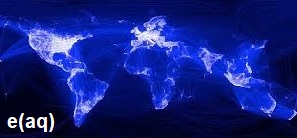
Spoiler: It is. Skip the discussion and go right to the answer.
Here's the investors' page
if you're lost, a short LinkedIn article for the quickest orientation, Artificial Lightning Seen as Clean Energy Breakthrough and its brief follow-up Artificial Lightning Startup - Generating Low Energy Pair Production Of Electrons In Water.
That would be some pretty bold, good news if true, wouldn't it?
If you have a few minutes, let's walk through the possibilities.
In your wildest imagination, what would the ideal energy breakthrough innovation be like?
What qualities, capabilities, properties and attributes would it have?
 This is what I came up with.
This is what I came up with.
It would be useable.
Obviously, it can't be just an idea. It has to be a thing, like electrons out of thin air, on-demand, anytime, anywhere.
It would be reliable.
 We would want it to be consistent and trustworthy, a source of confidence.
We would want it to be consistent and trustworthy, a source of confidence.
It would use what's happening in nature anyway, like the proverbial sun coming up in the morning, and tailor it to our advantage.
It would be fast.
The ideal breakthrough innovation would be instantaneous and continuous, always ready for speed-of-light convenience on-demand.
It would take advantage of the fact that activity at the smallest scales in nature, the atomic and molecular level, and of light itself,
is a lot quicker than at our scale, and very reliably repeats itself a quadrillion, 1,000,000,000,000,000, i.e., 10^15 times per second.
This would allow us to use time as a tool, freeing us from repetitious, time-consuming efforts such as mining, drilling, recharging and refueling.
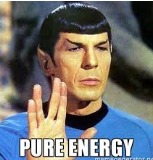
It would be compact.
It would consist of materials that are neatly packed for the best density, affording us utility and convenience while
allowing for decentralization and wide distribution.
With a small footprint, it would appeal aesthetically.
Imagine a handy little power crystal, like something from 1960s science fiction.
Combining the last three attributes, reliable, fast and compact, our ideal breakthrough energy
innovation would be efficient.
 It would embody the best use of materials, time and space to achieve a desired result.
This is generally called energy density.
How long and how fast the energy can be used, are described in different terms.
But since we want it repeatedly, for as long as we want and all of the time, it's easy to simplify to the notion of energy density plus time.
Ideally, it would do most of the work using natural phenomena hardwired by nature and recurring in time, so that once
deployed, it just does what it does until we stop it.
It would embody the best use of materials, time and space to achieve a desired result.
This is generally called energy density.
How long and how fast the energy can be used, are described in different terms.
But since we want it repeatedly, for as long as we want and all of the time, it's easy to simplify to the notion of energy density plus time.
Ideally, it would do most of the work using natural phenomena hardwired by nature and recurring in time, so that once
deployed, it just does what it does until we stop it.
The energy breakthrough would produce the most useful reactions in the largest numbers,
in the least time and repeatedly, within the smallest space.
To visualize such ideal efficiency, think of the energy released from the atomic bomb by only two pounds of reactive material.
Remember those first grainy moving images from the 1940s?
Now imagine them reversed and in slow motion.
Instead of exploding light, heat and radiation, we'd capture such energy from the sun and other stars and focus it for
a far more productive end.
We'd like to cause something like that to happen not only just once and explosively, but continuously, smoothly and repeatedly
at 10^15 times per second.
This would allow a physically much smaller space to produce reliable on-demand energy.
It would use "too good to be true" math.
 The atomic bomb example shows how we can use our cosmic spot, roughly in the middle scale of space, to our advantage.
We have yet to fully explore these same advantages in time.
The atomic bomb example shows how we can use our cosmic spot, roughly in the middle scale of space, to our advantage.
We have yet to fully explore these same advantages in time.
Math explains how the "too good to be true" actually is true, and makes the "impossible" easier to accept objectively.
I like to think of it this way:
"Large numbers of little things, doing little things quickly and repeatedly, add up to very big things."
It would use easily-explainable science.
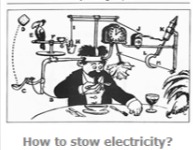 Ideally, for the sake of confidence, we'd want to know why an innovation is efficient and reliable.
As we advance technologically, there is no reason why such knowledge can't be made increasingly understandable and accessible
to the average person.
Ideally, for the sake of confidence, we'd want to know why an innovation is efficient and reliable.
As we advance technologically, there is no reason why such knowledge can't be made increasingly understandable and accessible
to the average person.
The breakthrough needn't necessarily be based on some new discovery, but perhaps on old, established
reliables put together in a new and better way.
It could use well-known natural principles, but perhaps more wisely.
For example, consider our atomic bomb in reverse.
It's constructive, not destructive.
Think of it smoothly, continuously, coherently, consistently, focusing productively, instead of exploding only once.
Concepts like that are easy to understand.
It would be self-actuating, continuously using the least amount of effort to perpetuate itself.
We'd like to just set up our ideal device and let it run.
It would continuously be doing something useful in keeping with its hardwired nature.
It would just keep going, in the way we think of fire feeding itself, eliminating or minimizing the need for constant recharging, refueling, and the like.
"Nature-based" applies here because highly efficient natural devices already exist that do most of the work we envision, such as atoms, molecules and photons.
Reliably, they always behave in a certain ways in certain circumstances, just like the sun coming up in the morning.
Our mission is to create and perfect the ideal circumstances.
There may be no "perpetual motion", but fourteen billion years and still ticking is a good start.
 It would be sustainable.
It would be sustainable.
 Why is sustainability an ideal attribute?
Because it's reliability plus time, something that won't run out.
We'd like our breakthrough innovation to approach the perpetual, or to at least to give us the confidence that we'll have it available to us for "long enough".
Why is sustainability an ideal attribute?
Because it's reliability plus time, something that won't run out.
We'd like our breakthrough innovation to approach the perpetual, or to at least to give us the confidence that we'll have it available to us for "long enough".
It would be made with and run on, abundant materials and natural occurrences.
For the sake of cost, convenience and reliability, we'd prefer using things that are easy to find, make and replace.
Ideally, it would be composed of as many readily available materials as possible.
These would likely be basic elements making the best use of their natural tendencies in an environment of common natural occurrences.
Of course, we'll have to set them up to optimize.
And undoubtedly, some very fancy technology will be facilitating at the atomic, molecular and photonic level, probably metamaterials and optomechanical devices.
It would be achievable.
 First, we must be able to visualize our ideal innovation confidently, knowing that it can be realized.
We'll have to create the conditions that allow basic elements to operate at peak efficiency.
That's where our own nature, as "nature-based" problem solvers, comes in.
This will have to be thought through first with cold realism, not giddy idealism,
while bearing in mind that when nature meets human practicality and engineering meets imagination, it's no time to be timid.
First, we must be able to visualize our ideal innovation confidently, knowing that it can be realized.
We'll have to create the conditions that allow basic elements to operate at peak efficiency.
That's where our own nature, as "nature-based" problem solvers, comes in.
This will have to be thought through first with cold realism, not giddy idealism,
while bearing in mind that when nature meets human practicality and engineering meets imagination, it's no time to be timid.
Perhaps no phrase has ever been more of a "reality distortion" than "it can't be done".
To date, progress has favored the optimistic.
It would be simple.
The "ideal" would be devoid of unnecessary complexity restricting our use and understanding.
It would use basic physical and chemical reactions optimally, with the fewest materials and moving parts.
It would be easy-to-understand, operate and maintain.
It will be easier to explain to a typical child of the future than the well-educated adult of the present.
It would be anthropic, compatible with human life.

For the sake of health and safety, it would favor smooth operation over unnecessarily dangerous force and produce the minimal amount of byproducts.
It would allow for flexibility and freedom, and be widely distributable, useable anywhere.
It would be intuitive.
The ideal breakthrough energy innovation would seem intuitive in its design, use and intelligibility.
It would fit seamlessly with human behavior and sensibilities.
Its archetypes might even remind us of the "nice" part of nature, green, clean, comforting and peaceful.
It would encourage us to feel like part of a system.
It would be innovative.
Finally, it would be innovative, not simply change for change's sake, but because adapting to, or even considering novel
originality is often how we imagine new things ourselves.
Innovation in itself benefits us all, expanding the entire paradigm horizon.
And here we are.
"If you do what you always do, you get what you always got." - Albert Einstein
 Well, that was a nice wish list, but what if this ideal is entirely possible?
Well, that was a nice wish list, but what if this ideal is entirely possible?
What if the "breakthrough" came about by simply reframing the problem, combining old reliable, but disjointed scientific silos
and optimizing what we already know?
Maybe we really can look to nature for basic, smooth and continuous low energy reactions that "add up" to something useful.
It might be something as ruthlessly efficient as the atomic bomb but gentle as a floating cloud.
It is suggested that this is indeed achievable, and the next breakthrough energy solution may well have been found.
In fact, it might look exactly like the Excess Aqueous Electron - Artificial Lightning Generator, or e(aq) for brevity.
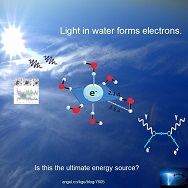 Essentially, this is an optomechanical device which enhances the inherent capabilities of water, light and hydrogen to generate and store excess aqueous electrons.
For a quick overview, click on the image, it goes to the "ad" slides.
The images there and the balance of this webpage are meant to give you an idea of how and why this idea works.
Essentially, this is an optomechanical device which enhances the inherent capabilities of water, light and hydrogen to generate and store excess aqueous electrons.
For a quick overview, click on the image, it goes to the "ad" slides.
The images there and the balance of this webpage are meant to give you an idea of how and why this idea works.
In water clusters of four-to-six molecules, two-to-four photons of certain wavelengths centering around visible light
can be made to merge in overlapping hydrogen orbitals, generating new, large, low energy electrons.
The new electrons will then shrink, and may be moved to the conduction band or removed for beneficial use.
The process happens within the femtosecond range, i.e., up to 10^15 times per second.
It occurs in both water and ice under easily-achieved, almost ambient conditions.
This phenomenon has been variously and vaguely described since 1963. I've speculated upon and suspected its existence
for years, slowly piecing this together from hundreds of scholarly articles.
I argue that evidence for the utility of the e(aq) is highly persuasive and completely unappreciated, if not entirely unnoticed.
This is quite possibly the most significant energy-related reaction since nuclear fission, and recent articles are becoming more and more on point.
Extrapolating the behavior of small particles into breakthrough energy miracles probably isn't task-specific routine science,
but it is where the "fresh eyes" cliché has historically proved its worthiness.
Easy ways to think of this include "artificial lightning", "low energy pair production", "the bottomless water battery", "photochemical electricity" and "solar x 10^15".
Until one of these names or concepts takes hold, it will be abbreviated here as e(aq), short for "excess aqueous electron",
rather than using the cumbersome "Excess Aqueous Electron Generator".
"Large numbers of little things, doing little things quickly and repeatedly, add up to very big things."
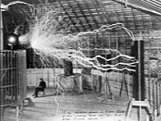
In light of this proposed method, let's address those ideal attributes again and see how it measures up.
We'll do it in reverse order this time, from the "wish list" to the most useful and basic.
It's innovative.
This is a completely original approach from inspired fresh eyes.
It's entirely novel, not simply change for change's sake or another predictable iteration.
It came about unintentionally and independently, through curiosity, intuition, observation and research free of corporate, governmental or institutional influence.
As a result, this is the first and only energy approach to combine light, i.e., photons, converting them directly into newly formed electrons.
That alone makes it singular and distinctive, and why it may be called a "breakthrough".

It's intuitive.
Once its basic natural principles are understood in their simplicity, the e(aq) seems intuitive, comporting well with human sensibilities.
One of its archetypes, electricity formed in clouds, has been hiding in plain sight all along and reminds us of the pleasant aspects of nature,
green, clean, comforting and peaceful.
The notion of light in water combining to create new electrons is easy to understand when we drop the math and science for a moment and think intuitively.
We've seen a rainbow's water droplets split light into a spectrum, like a prism, and can easily envision light similarly captured, changed and combined within clouds.
Under the right conditions, the photons intertwine, entangle and merge to form a new particle, an extra, "excess" electron.
The e(aq) and blue visible light are interrelated, as are blue ice, blue water, and the tint of "electric blue" lightning.
It's quite often the wavelength captured by an e(aq) (although not necessarily the precise species we'll use) and is
similar to the visible light and heat trapped in hydrocarbons.
It's all "quantum theory", but in this case, since we can easily see it, it's a bit more intuitive.
 Further, we know the experience of lightning, vast amounts of electricity somehow produced in clouds without turbines or panels, but merely by simple water molecules exposed to the sun.
Further, we know the experience of lightning, vast amounts of electricity somehow produced in clouds without turbines or panels, but merely by simple water molecules exposed to the sun.
Replicating that seems sensible, intuitive and instinctive.
Even a guy like Bill Gates, with lots of available diversions at his disposal, spends time thinking about water chemistry, solar energy and
Beating Nature at Its Own Game.
That's the essence of what we're doing here.
It's anthropic, amenable and compatible with human life.
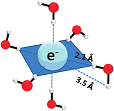 The e(aq) approach favors clean, smooth operation over unnecessarily dangerous force.
Other than the generic challenges nanotechnology manufacturing presents, it will produce the minimal amount of byproducts, making it distributable and useable anywhere.
This allows flexibility and freedom.
The e(aq) approach favors clean, smooth operation over unnecessarily dangerous force.
Other than the generic challenges nanotechnology manufacturing presents, it will produce the minimal amount of byproducts, making it distributable and useable anywhere.
This allows flexibility and freedom.
The process uses only ambient light and does so highly efficiently.
The challenge of right-sizing to avoid excess electricity generation will have to be considered however, which is a good problem to have.
"The intuitive mind is a sacred gift and the rational mind is a faithful servant. We have created a society
that honors the servant and has forgotten the gift." - Albert Einstein
It's simple.
 This process is deceptively simple to understand. It's "subtle but not malicious", one might say.
Essentially, it's only water forming new electrons from light, which happens naturally anyway.
It uses basic physical and chemical reactions optimally, and eliminates unnecessary complexity.
This process is deceptively simple to understand. It's "subtle but not malicious", one might say.
Essentially, it's only water forming new electrons from light, which happens naturally anyway.
It uses basic physical and chemical reactions optimally, and eliminates unnecessary complexity.
"Breakthrough" talk notwithstanding, big problems don't necessarily require complicated solutions.
Sometimes the answers are hiding in plain sight and significant insights emerge from everyday experiences. Methods of harvesting and harnessing lightning have been considered for quite some time. Inexplicably, replication of lightning has been pursued less so, if at all.
Although this innovation can be described with impressive scientific obscurantism, Feynman diagrams and equations
involving quantum theory, it's also just a reverse-engineered, nature-based solution.
If ambient light is shining through your water bottle at a nuclear conference in Charlotte,
just shake it a little and you've created new electrons, albeit short-lived ones.
When the sun beats down on a blindingly white cloud in Georgia the whole day through
and electrified white pulses come back out of it that night for hours on end, maybe there's a very simple reason for it.
And perhaps there's something universally applicable we can learn from it.
Throughout history, seemingly mundane observations like those have inspired more than a few innovations.
This is another one of those times.
It's achievable.
Some of you are starting to visualize this, knowing that it can be realized, understanding that it will take a singularly focused effort.
This is where our own nature, as "nature-based" problem solvers, comes in.
We can create the conditions which will allow these basic components to operate at peak efficiency and our lives will improve dramatically.
It'll have to be carefully thought through first, but the concept is undeniably sound.
It simply reflects the physical world as it is.
 With the foundation proposed here, we can imagine creating the last source of electrical energy we'll ever need and achieve it.
With the foundation proposed here, we can imagine creating the last source of electrical energy we'll ever need and achieve it.
It's not going to leap off the screen and become a reality, however.
It's been a slow, patient pursuit to get only this far.
This is not even close to a "moonshot" or Manhattan Project yet, merely a compelling concept meriting careful consideration.
Exploring its potential is in our nature as curious humans, and will cost very little, especially in light
of some of the "cleantech", "greentech" and government-mandated energy breakthrough "nudge" investment dollars lost over the last decade.
Instead of more of the same, we'll need people that are interested and involved in creating fresh technology, i.e., understanding a new application for the
basic physics described here.
It should begin as a steady, rigorous effort by dedicated people moving prudently in the manner of e.g., the
Joint Center For Artificial Photosynthesis or the
Joint Center For Energy Storage, but privately.
This is a chance to go far beyond the current short-sighted goals of the status quo and consider something completely new.
The Photonic Age has dawned and energy breakthroughs are going to emerge.
This is one of the first.

It's made with and runs on, abundant materials and natural occurrences.
These are simply basic elements making the best use of their natural tendencies for our benefit.
The sun and stars are going to shine whether we use them ideally or not at all.
We'll have to set it all up to optimize of course, and some very fancy technology will be facilitating at the atomic, photonic and molecular levels.
Opportunities will abound in research, manufacturing, metamaterials and especially in the nascent optomechanical industry, once
described by its leadership as an exciting new field in search of something to do.
As in nature, ambient natural light is simply changed into electricity.
Water and hydrogen are not consumed, but used only to make and store electrons.
"Nothing is more imminent than the impossible... what we must always foresee is the unforeseen." - Victor Hugo
It's sustainable.
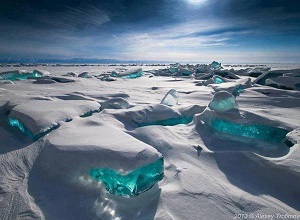 For reliability plus time, the e(aq) depends primarily on things that won't run out soon, such as water, hydrogen, light and time itself.
This gives us confidence that we'll have it available for "long enough".
We can envision it approaching the perpetual.
For reliability plus time, the e(aq) depends primarily on things that won't run out soon, such as water, hydrogen, light and time itself.
This gives us confidence that we'll have it available for "long enough".
We can envision it approaching the perpetual.
Think about it.
Somewhere out on Planet X, a water cluster trapped in an ice block is continuously absorbing and merging photons,
creating 10^15 excess aqueous electrons every second, just as it has long before our sun ever existed.
That very process is similar to what's happening in the clouds above you right now and is just waiting to be put to use by us.
We will make our own ice block and plug right into it.
It's only a matter of time.
 It's self-actuating, continuously using the least amount of effort to perpetuate itself.
It's self-actuating, continuously using the least amount of effort to perpetuate itself.
Water clusters, hydrogen molecules and atoms do what they do, reliably on their own.
We'll just set up our ideal device, let the light shine in and allow it to run.
It will continue to combine photons in keeping with its hardwired nature, producing the electrons we need.
These nature-based, highly efficient natural components are already doing most of the work we envision anyway.
Reliably, they always behave in certain ways in certain circumstances, just like the sun coming up
in the morning.
While there may be "no such thing as perpetual motion", fourteen billion years and still ticking is a good start.
The thing with water is, if you keep feeding it photons, it will keep generating new electrons.
But don't take my word for it.
It uses easily-explainable science.
The science behind this can be made understandable to the average person.
It's not some new discovery, just a couple of established old reliables put together in a new and better way.
We know that water clusters are efficient and reliable, smoothly and repeatedly combining photons to produce new electrons,
but simply have not applied this knowledge.
Whether we dig into the depths of scientific complexity as far as it goes, or just use common sense, the results are the same.
The way forward is clear.
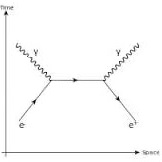
Someday, hindsight may describe this as a natural, obvious iterative step based on quantum theory.
It simply and inevitably moved the frame from Maxwell to Einstein.
Others may call it an accidental dumbing-down backward into sheer elegance.
We'll see.
What follows is an excerpt from an explanation in "plain English" requested by a national energy laboratory that has been kind enough to take this under consideration:
"Typically, the e(aq) is generated upon the introduction of 2-4 photons of various energies into water clusters.
Multiphoton attributes this to, "overlapping 3s Rydberg orbitals on adjacent molecules" and "exciton decay", (page 17945 second column, first full paragraph).
Similarly, Direct describes the "overlaps" (page 697 second column, first partial paragraph) and "molecular-based mechanisms and bulk excitation", (page 697 second paragraph).
The e(aq)'s initial size, roughly 3-4.25 A, from Direct, also roughly comports with the size of the overlapping orbitals and cavities.
It takes a lot of reading and re-reading of these papers, but eventually, it all seems to corroborate.
Two excess photons merge within the overlaps of hydrogen orbitals to generate the new, larger, extra, e(aq).
This drawing illustrates that explanation.
And here, I will attempt to explain it in plain English:
"In water clusters of 4-6 molecules, 2-4 photons of certain wavelengths, centering around visible light,
can be made to merge in overlapping hydrogen orbitals, generating new, large, low energy electrons.
The new electrons will then shrink, and may be moved to the conduction band or removed for beneficial use.
The process happens within the femtosecond range, i.e., a million billion times per second.
It occurs in both water and ice under easily-achieved, almost ambient conditions."
And this is an excerpt from some correspondence of early 2018 that's fairly concise:
"Yes, "artificial lightning" sounds hokey, but it's certainly more memorable than "the low energy excess aqueous electron". Since "artificial photosynthesis" and the "artificial leaf" have already been mainstreamed, why not?
Anyway, if you recall, I gave you a quick description in response to your "black box" question. Here it is again in writing:
Input -- Two photons, ranging from visible violet-blue to near-ultraviolet.
Contents -- One cluster of four-to-six glassy water ice molecules.
Output -- One new, stored, large low energy electron which will shrink to normal size and energy when released from the box.
Please note, this is neither indirect or direct ionization. The energies involved are simply too low. Additionally, the box itself may be made of carbon nanotubes, which can give ambient liquid water an ice-like electronic structure.
If the photon energy is higher than specified above, the expected ionization occurs. If it's too low, the electron will decay back into the visible, scattering white light. Hence, the "lightning" comparison.
The process appears to be low energy pair production, similar to gamma photons colliding to form an electron. But here, new electrons are created from photons ranging to the visible, probably in overlapping hydrogen orbitals. Scholarly articles, mostly by chemists and biochemists, offer speculation about the mechanism but ultimately describe it as "unclear" or "not well-understood" and move on.
Needless to say, this happens extremely quickly with energy dense, clean abundant materials found throughout the solar system, photons and water. Once we better understand this process, it can be controlled.
This could be the basis for a zero carbon "last generation solar cell" and light-rechargeable "battery 2.0", all-in-one. It's hard to imagine simpler, more efficient materials and processes.
This is black box-like drawing I made for ... of ... when we were corresponding about this. He was kind enough to provide some questions and advice...
I would however, like to direct you to Argonne's Multiphoton Ionization of Liquid Water with 3.0-5.0 eV Photons. It's probably the best introduction to this for someone with your extensive background. Most of the ionization anomalies are covered there."
There is an unpublished webpage describing all of this and ways to accomplish it in mind-numbing detail with some 200 footnotes, mostly scholarly articles,
but that must remain confidential for now.
In the meantime, those interested should investigate along the lines of
"hydrated electron", "solvated electron", "electronic structure of ice", "graphene electrode", "pair production", "Grotthuss mechanism", "water wire", "hydrogen spectrum",
"hydrogen storage" and "lightning" in Google and Google Scholar for a few years, or else start here with
Direct observation of the collapse of the delocalized excess electron in water
for a quick but thorough overview.
We're going to tie all that together using metamaterials and optomechanics.
It uses "too good to be true" math.

This underlying principle represents a major distinction from the current thinking, capitalizing fully upon the rules of causation.
We can use our cosmic spot, roughly in the middle scale of both time and space, to our advantage.
The "too good to be true" actually is true, and when applied to the physical world, makes the "impossible" easier to accept objectively.
We've done this before with space to an extent, e.g., the atomic bomb, rockets and nuclear power, but not fully in time.
The e(aq) uses time as a tool, another reason it can be called a "breakthrough".
Fasten your seat belt and start thinking along these lines.
Let's say it takes four-to-six moles (10^23 molecules) of water to get one mole of
water clusters which, when sufficiently bathed in light or quenched in energized hydrogen, will
produce 10^23 electrons, each with charge of 10^-19 (something-something) at a rate of 10^15 times a second.
The 10^23, 10^-19, 10^15 makes it look like 10^19 of something is happening every second, doesn't it?
I'll leave the joules, eVs, watt-hours and other gorgonzola to you.
Do it for yourself and get it over with, that's the best way to learn and quickest way to form an opinion.
You'll see that it adds up to astronomical amounts of power.
The numbers quickly overwhelm, and it becomes easier to just think of this as a concept.
 Now let's compare this "10^15" engineering design philosophy to the "one and done" Rube Goldberg transactions of a popping hydrocarbon bond or a fizzling fizzled-out
uranium fission, and the very limited amount of previously-existing, merry-go-round electrons in a wind turbine, lithium ion battery or solar panel.
Think about how much more can one water cluster can do, if used correctly.
Now let's compare this "10^15" engineering design philosophy to the "one and done" Rube Goldberg transactions of a popping hydrocarbon bond or a fizzling fizzled-out
uranium fission, and the very limited amount of previously-existing, merry-go-round electrons in a wind turbine, lithium ion battery or solar panel.
Think about how much more can one water cluster can do, if used correctly.
Imagine finding a humble penny.
Now imagine finding 10^15 pennies.
Next, imagine finding 10^15 pennies a second, every second.
Notice that the rote rapid quick repetition routine I keep repetitiously repeating starts to mean a lot when doing math with a ubiquitous "10^15" tacked on to everything.
If there's a twist, kicker or trick to all this, that's it.
Except it's none of those things. It's math. Those are the rules.
Ponder it. Play around with it.
Now do you see the inevitability?
"Large numbers of little things, doing little things quickly and repeatedly, add up to very big things."
It's efficient, i.e., reliable, fast and compact.
Efficiency happens when using the "is" correctly.
The e(aq) embodies the best use of materials, time and space to achieve a desired result.
This is nearly optimal energy density, used in time at full capacity.
It will do this work repeatedly, for as long as we want and all of the time, using natural phenomena hardwired by nature.
Once deployed, it just does what it does until we stop it, thoroughly fulfilling and satisfying the notion of energy density plus time.
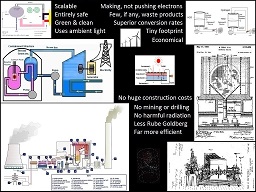
To viscerally comprehend such vastly improved efficiency, think again of the energy released by the atomic bomb from only two pounds of reactive material.
Visualize it reversed and in slow motion.
Instead of the exploding light, heat and radiation, imagine it coherently captured from the sun
and other stars, and pulled through two pounds of material for a far more productive end.
Visualize it happening continuously, smoothly and repeatedly at 10^15 times per second, far faster than we can see.
The repetition allows a physically much smaller space to produce such astronomical amounts of reliable, on-demand electrons.
Using more of the fourth dimension allows us to use less of the other three.
Understanding that concept is how we go from looking askance at claims of "solar x 10^15" to acceptance of a powerful reality.
This is a material with superior density, which is used for a far more efficient process and does so repeatedly, fully utilizing time.
Proponents of such forward-looking concepts as bidirectional power plants, deterministic renewables and long duration flow batteries are advised to take a hard look at this solution.
To say that it compares quite favorably to current and proposed methods is an understatement.
Click on the comparison slide for a quick overview.
"The thing with water is, if you keep feeding it photons, it will keep generating new electrons."
 It's compact.
It's compact.
The e(aq) primarily uses materials that are neatly packed by nature for the best density and reused repeatedly.
This provides utility and convenience, allowing decentralization and wide distribution.
With a small footprint, it will appeal aesthetically.
It'll be tough, if not impossible, to compete with the energy density and absolute utility of water generation and hydrogen storage for this application.
The next level can be envisioned, but probably won't be feasible for quite some time.
 The handy little power crystal from science fiction isn't far off.
We'll just have to work for it.
The handy little power crystal from science fiction isn't far off.
We'll just have to work for it.
When I first fully realized that a small amount of water can do so much, it hit with a visceral reaction.
I was stunned and in awe, nauseous and briefly but indefinably fearful.
I didn't want to believe it.
Frankly, it put me in a numbed daze for a little while and still does when diving back in too deep.
Once you've viscerally "felt" this concept in the body and mind, it blends, mixes and merges into acceptance.
There was a too-long anecdote edited from here, ending with the conclusion that I ultimately adapted by
relying on the bomb example, math and my own nuclear power background to finally rationalize this.
The world looks different, old and slow, but cozy old-timey.
And now I'm duty-bound to propose this, as tinfoil hat crazy as it seems, knowing that
the math is what it is and the science says what it says, ultimately substantiating an unshakeable confidence.
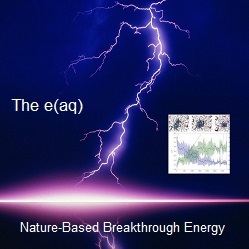 It's fast.
It's fast.
The e(aq) is instantaneous and continuous, always ready for speed-of-light convenience on-demand.
It takes full advantage of the fact that activity at the smallest scales in nature, atomic, molecular,
and, of course, light itself, is a lot quicker than things at our scale and very reliably repeats itself.
We'll use time as a tool and free ourselves from repetitious, time-consuming efforts such as mining, drilling, making fuel, recharging and refueling.
Light is the basic component here, photons our raw material.
It doesn't get any faster folks, and the formation of new electrons happens almost that quickly.
This will be capable of producing large amounts of electricity faster than anyone will want for a while, unless they have some urgent need to fill the Grand Canyon with electrons.
It's reliable.
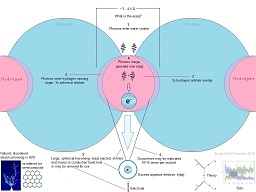 Hydrogen, water molecules and photons are consistently trustworthy sources of confidence, like the proverbial sun coming up in the morning.
So we'll simply use what's happening in nature anyway.
Hydrogen, water molecules and photons are consistently trustworthy sources of confidence, like the proverbial sun coming up in the morning.
So we'll simply use what's happening in nature anyway.
Water reliably makes electrons (click on the image for a step-by-step description).
It's an ideal pre-existing metamaterial that does exactly what we need. This is the next, and quite possibly the last generation solar cell.
Is what it is, and it does what it does. It's been fourteen billion years or so and the universe is still ticking.
It's fun to face the facts when they're so unbelievably good, isn't it?
Finally...
It's useable.
Bottom line, the ideal breakthrough energy source, like electrons out of thin air, on-demand anytime, anywhere, already exists.
It is electrons out of thin air.
It turns out that the magic little power crystal packed with pure energy science fiction writers intuitively foresaw was entirely possible.
In fact, it was probable and inevitable, not magic at all.
This page told you what it is.
But how can this be?
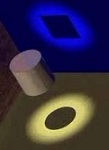 One day somebody accidentally found an answer and asked, "What problem does this thing best solve?"
The problem didn't take long to find.
He had worked backward out of curiosity and tripped over a black swan.
Nothing was intentionally reverse-engineered, but a nature-based solution was found anyway.
One day somebody accidentally found an answer and asked, "What problem does this thing best solve?"
The problem didn't take long to find.
He had worked backward out of curiosity and tripped over a black swan.
Nothing was intentionally reverse-engineered, but a nature-based solution was found anyway.
The purpose-driven concept of reverse-engineering from nature, to "beat it at its own game", or "flying without feathers",
is perhaps the best guiding principle that science and engineering have going for them right now.
I'd like to see more straightforward efforts like this one, the Joint Center For Artificial Photosynthesis.
In fact, this webpage is meant in-part to likewise inspire a similar endeavor, a private breakthrough energy venture for artificial lightning.
We might then also take the next inevitable step and start looking to the very nature of things, such as light, water,
hydrogen and time itself used here, to see what do they do best and consider what they are there for.
God's thoughts were good enough for Einstein, they ought to be good enough for the innovation culture.
But let's save the philosophy for another round of Poppers and Kuhns, shall we?
Right now, it should be recognized that the e(aq) is quite possibly the ideal solution to the problem at hand.
Let's admit that nature is on to something here and use it, instead of trying to wishfully think unicorns into existence.
What we already have in water seems to provide more than enough potential.
Final Notes
Despite this quaint presentation, I'd expect more than a few will come away somewhat persuaded that this solution is shockingly close to an ideal,
one they never thought they'd see.
Join the club.
The biggest problem right now is its unconventional source, although the conventional ones are slowly beginning to show more and more interest.
Fortunately, the physics ultimately makes the argument idiot-proof and self-evident.
It's eventually going to happen anyway.
But why wait another 300 years?
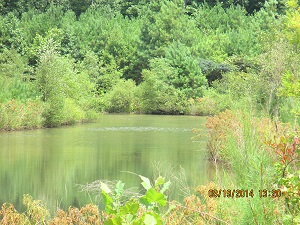
So now I'm looking to you asking for help.
That's you venture capitalists, national energy labs, Peter Thiels, Bill Gateses, journalists, green energy fans, science illustrators, ecomodernists, futurists, artists, Secretary Perrys, academics, fundraisers, social media buzz-causers, 'real' scientists looking for that first Nobel Prize just for formalizing this,
energy policy wonks, activists, enviros, climate change-concerned billionaires at Breakthrough Energy Ventures
or anyone else at all interested.
Here's a very special link just for the venture capitalists, addressing your concerns with
some hipster IP jargon about scaling black swans and pivoting unicorns:
Too Cheap To Meter - A Black Swan Hiding In Plain Sight.
Decks, pitches, speeches, double-secret trade secrets, unpublished webpages, patent documents and the like are available for discussion.
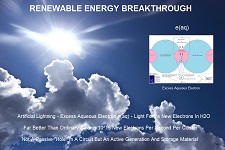
Like long stories? Read a speech about why harnessing and harvesting lightning photochemically may be the ideal clean energy solution.
Questions and comments are welcomed on Twitter
or by email, bk@suretyinsider.com.
Thank you.
*Nature-based solutions is the latest green jargon that means more than you might think, 11 January 2017, Nature
"It may sound vague, but the term represents real and vital concepts."
© 2017 Bryan Kelly


 What if the ideal breakthrough energy solution were also easily-achievable?
What if the ideal breakthrough energy solution were also easily-achievable?

 This is what I came up with.
This is what I came up with.
 We would want it to be consistent and trustworthy, a source of confidence.
We would want it to be consistent and trustworthy, a source of confidence.

 It would embody the best use of materials, time and space to achieve a desired result.
This is generally called energy density.
How long and how fast the energy can be used, are described in different terms.
But since we want it repeatedly, for as long as we want and all of the time, it's easy to simplify to the notion of energy density plus time.
Ideally, it would do most of the work using natural phenomena hardwired by nature and recurring in time, so that once
deployed, it just does what it does until we stop it.
It would embody the best use of materials, time and space to achieve a desired result.
This is generally called energy density.
How long and how fast the energy can be used, are described in different terms.
But since we want it repeatedly, for as long as we want and all of the time, it's easy to simplify to the notion of energy density plus time.
Ideally, it would do most of the work using natural phenomena hardwired by nature and recurring in time, so that once
deployed, it just does what it does until we stop it.
 The atomic bomb example shows how we can use our cosmic spot, roughly in the middle scale of space, to our advantage.
We have yet to fully explore these same advantages in time.
The atomic bomb example shows how we can use our cosmic spot, roughly in the middle scale of space, to our advantage.
We have yet to fully explore these same advantages in time.
 Ideally, for the sake of confidence, we'd want to know why an innovation is efficient and reliable.
As we advance technologically, there is no reason why such knowledge can't be made increasingly understandable and accessible
to the average person.
Ideally, for the sake of confidence, we'd want to know why an innovation is efficient and reliable.
As we advance technologically, there is no reason why such knowledge can't be made increasingly understandable and accessible
to the average person.
 It would be sustainable.
It would be sustainable.
 Why is sustainability an ideal attribute?
Because it's reliability plus time, something that won't run out.
We'd like our breakthrough innovation to approach the perpetual, or to at least to give us the confidence that we'll have it available to us for "long enough".
Why is sustainability an ideal attribute?
Because it's reliability plus time, something that won't run out.
We'd like our breakthrough innovation to approach the perpetual, or to at least to give us the confidence that we'll have it available to us for "long enough".
 First, we must be able to visualize our ideal innovation confidently, knowing that it can be realized.
We'll have to create the conditions that allow basic elements to operate at peak efficiency.
That's where our own nature, as "nature-based" problem solvers, comes in.
This will have to be thought through first with cold realism, not giddy idealism,
while bearing in mind that when nature meets human practicality and engineering meets imagination, it's no time to be timid.
First, we must be able to visualize our ideal innovation confidently, knowing that it can be realized.
We'll have to create the conditions that allow basic elements to operate at peak efficiency.
That's where our own nature, as "nature-based" problem solvers, comes in.
This will have to be thought through first with cold realism, not giddy idealism,
while bearing in mind that when nature meets human practicality and engineering meets imagination, it's no time to be timid.

 Well, that was a nice wish list, but what if this ideal is entirely possible?
Well, that was a nice wish list, but what if this ideal is entirely possible?
 Essentially, this is an optomechanical device which enhances the inherent capabilities of water, light and hydrogen to generate and store excess aqueous electrons.
For a quick overview, click on the image, it goes to the "ad" slides.
The images there and the balance of this webpage are meant to give you an idea of how and why this idea works.
Essentially, this is an optomechanical device which enhances the inherent capabilities of water, light and hydrogen to generate and store excess aqueous electrons.
For a quick overview, click on the image, it goes to the "ad" slides.
The images there and the balance of this webpage are meant to give you an idea of how and why this idea works.


 Further, we know the experience of lightning, vast amounts of electricity somehow produced in clouds without turbines or panels, but merely by simple water molecules exposed to the sun.
Further, we know the experience of lightning, vast amounts of electricity somehow produced in clouds without turbines or panels, but merely by simple water molecules exposed to the sun.
 The e(aq) approach favors clean, smooth operation over unnecessarily dangerous force.
Other than the generic challenges nanotechnology manufacturing presents, it will produce the minimal amount of byproducts, making it distributable and useable anywhere.
This allows flexibility and freedom.
The e(aq) approach favors clean, smooth operation over unnecessarily dangerous force.
Other than the generic challenges nanotechnology manufacturing presents, it will produce the minimal amount of byproducts, making it distributable and useable anywhere.
This allows flexibility and freedom.
 This process is deceptively simple to understand. It's "subtle but not malicious", one might say.
Essentially, it's only water forming new electrons from light, which happens naturally anyway.
It uses basic physical and chemical reactions optimally, and eliminates unnecessary complexity.
This process is deceptively simple to understand. It's "subtle but not malicious", one might say.
Essentially, it's only water forming new electrons from light, which happens naturally anyway.
It uses basic physical and chemical reactions optimally, and eliminates unnecessary complexity.
 With the foundation proposed here, we can imagine creating the last source of electrical energy we'll ever need and achieve it.
With the foundation proposed here, we can imagine creating the last source of electrical energy we'll ever need and achieve it.

 For reliability plus time, the e(aq) depends primarily on things that won't run out soon, such as water, hydrogen, light and time itself.
This gives us confidence that we'll have it available for "long enough".
We can envision it approaching the perpetual.
For reliability plus time, the e(aq) depends primarily on things that won't run out soon, such as water, hydrogen, light and time itself.
This gives us confidence that we'll have it available for "long enough".
We can envision it approaching the perpetual.
 It's self-actuating, continuously using the least amount of effort to perpetuate itself.
It's self-actuating, continuously using the least amount of effort to perpetuate itself.


 Now let's compare this "10^15" engineering design philosophy to the "one and done" Rube Goldberg transactions of a popping hydrocarbon bond or a fizzling fizzled-out
uranium fission, and the very limited amount of previously-existing, merry-go-round electrons in a wind turbine, lithium ion battery or solar panel.
Think about how much more can one water cluster can do, if used correctly.
Now let's compare this "10^15" engineering design philosophy to the "one and done" Rube Goldberg transactions of a popping hydrocarbon bond or a fizzling fizzled-out
uranium fission, and the very limited amount of previously-existing, merry-go-round electrons in a wind turbine, lithium ion battery or solar panel.
Think about how much more can one water cluster can do, if used correctly.

 It's compact.
It's compact.
 It's fast.
It's fast.
 Hydrogen, water molecules and photons are consistently trustworthy sources of confidence, like the proverbial sun coming up in the morning.
So we'll simply use what's happening in nature anyway.
Hydrogen, water molecules and photons are consistently trustworthy sources of confidence, like the proverbial sun coming up in the morning.
So we'll simply use what's happening in nature anyway.

 One day somebody accidentally found an answer and asked, "What problem does this thing best solve?"
The problem didn't take long to find.
He had worked backward out of curiosity and tripped over a black swan.
Nothing was intentionally reverse-engineered, but a nature-based solution was found anyway.
One day somebody accidentally found an answer and asked, "What problem does this thing best solve?"
The problem didn't take long to find.
He had worked backward out of curiosity and tripped over a black swan.
Nothing was intentionally reverse-engineered, but a nature-based solution was found anyway.


